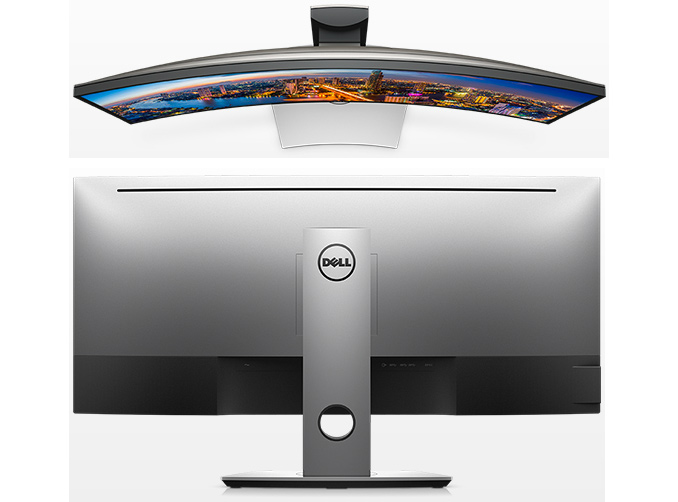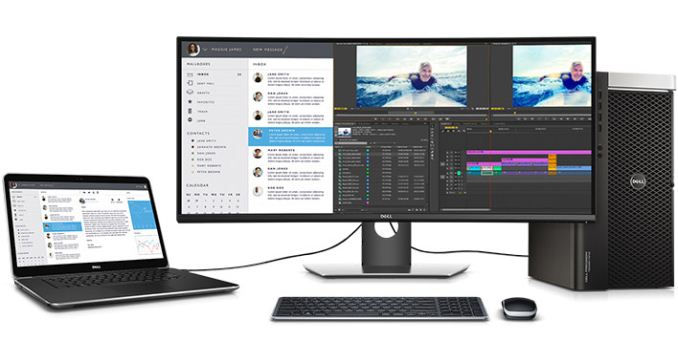Dell Unveils UltraSharp U3417W: Makes Its Curved Display More Curved
by Anton Shilov on September 14, 2016 11:00 AM EST- Posted in
- Monitors
- Dell
- IPS
- WQHD
- Ultrasharp
- Curved Display

Dell has unveiled its new top-of-the-range 34” curved monitor for consumers. The new UltraSharp U3417W display has the same WHQD resolution as the U3415W introduced a year ago, but increased curvature and a new chassis design. The monitor is aimed particularly at users who do heavy multitasking but do not want to install two monitors on their desks.
Nowadays, the majority of display makers position their curved monitors primarily for gamers and multimedia enthusiasts, thus, trying to incorporate very high refresh rates along with dynamic refresh rate technologies like AMD’s FreeSync or NVIDIA’s G-Sync. Meanwhile, Dell, quotes IDC’s findings that professionals from many industries (including those, who do finance, accounting and creative work) can benefit both from ultra-wide 21:9 aspect ratio as well as curvature. As a result, Dell offers curved monitors specifically tailored for professionals. Back in April, 2015, the company released its first U3415W curved display and this month it unveiled a newer model, the U3417W.
The Dell UltraSharp U3417W has higher curvature than its predecessor: 1900R vs 3800R. All the other specifications are generally similar: an IPS panel with 3440×1440 resolution, 1000:1 contrast ratio, 300 nits brightness, 178°/178° viewing angles, 5 ms response time in fast mode and a 60 Hz refresh rate. Dell believes that slightly higher curvature will further improve professional productivity.
| Dell's Curved Displays | ||
| UltraSharp U3417W 2016 model |
UltraSharp U3415W 2015 model |
|
| Panel | 34" IPS | |
| Native Resolution | 3440 × 1440 | |
| Maximum Refresh Rate | 60 Hz | |
| Response Time | 5 ms in fast mode 8 ms in normal mode |
|
| Brightness | 300 cd/m² | |
| Contrast | 1000:1 | |
| Viewing Angles | 178°/178° horizontal/vertical | 172°/178° horizontal/vertical |
| Curvature | 1900R | 3800R |
| Pixel Pitch | 0.233 mm | 0.2325 mm |
| Pixel Density | 109 ppi | unknown |
| Anti-Glare Coating | Yes | |
| Diagonally Viewable Size | 86.72 cm 34.14 Inches |
86.5 cm 34.055 inches |
| Preset Display Area | 799.80 mm × 334.80 mm 31.49" × 13.18" 267773.04 mm² 415.01 inches² |
798.20 mm × 334.80 mm 31.43" × 13.18" 267237.36 mm² 414.2474 inches² |
| Inputs | 1 × DP 1.2 (HDCP 1.4) 1 × mDP 1.2 (HDCP 1.4) 1 × DP 1.2 (out) with MST (HDCP 1.4) 2 × HDMI 2.0 (HDCP 1.4) |
1 × DP 1.2 1 × mDP 1.2 1 × DP 1.2 (out) with MST 1 × HDMI 2.0 1 × MHL |
| USB Hub | 4-port USB 3.0 hub, two ports support fast charging 2 USB Type-B upstream ports |
|
| Audio | 9 W × 2 audio in/out ports |
|
| Launch Price | $1199.99 | |
When it comes to connectivity, the UltraSharp U3417W resembles other modern monitors from the company (e.g., the UP3017) designed for professionals as it supports two HDMI 2.0, one DP 1.2, and one mDP 1.2 inputs. For convenience, it has one DP 1.2 output with MST to for daisy-chaining to another display. Besides, the monitor also supports PBP and PiP features when connected to two PCs. Finally, it has a quad-port USB 3.0 hub with two receptacles supporting BC 1.2 charging as well as two USB Type-B upstream ports (to connect to two different computers).
The Dell UltraSharp U3417W curved display is available now for $1199.99 from the manufacturer. Meanwhile, the older model, the U3415W is now available for $899.99. It is unknown whether Dell will keep selling both models, but for now the previous-gen display is available for the price, which is $300 below its original MSRP.
Source: Dell


















36 Comments
View All Comments
JoeyJoJo123 - Wednesday, September 14, 2016 - link
Image quality being better on the Dell is highly debatable; Both the Dell and the Acer theoretically use the same panels, therefore after setting both with proper calibrations they should look identical to the naked eye.They will look different right out of the box, and many Dell monitors (particularly Ultrasharp lineup) receive a decent enough calibration at the factory.
Black Obsidian - Wednesday, September 14, 2016 - link
Image quality is a safer bet on the Dell part, at the very least because of their warranty. Dell guarantees zero bright pixels for the (3-year) length of the warranty on their Ultrasharp displays, while Acer's general warranty considers anything less than 4 defective pixels per million to be acceptable, with no more than 1 in the center area of the display.I'm not likely to shell out $1K for a monitor only to have up to 15 defective pixels be something the manufacturer just expects me to live with. Perhaps not coincidentally, I've bought nothing but Ultrasharps for over a decade now.
IdBuRnS - Wednesday, September 14, 2016 - link
You mean people actually pay MSRP for Dell products?xthetenth - Thursday, September 15, 2016 - link
There's one very obvious possible reason, because you use the screen for work, where a sharper curve to help get the most out of the whole screen and daisy chaining and a USB hub that lets you hook up two computers and switch your two monitors, keyboard and mouse between them just by switching video input? I have the X34's freesync cousin, the XR341CK at home and the U3415W at work, and both screens are definitely the right screen for their use.nagi603 - Thursday, January 5, 2017 - link
If your GPU matches, having *Sync is much better than +25Hz. Hell, the experience is smoother than having the same refresh display if you have even the tinyest of (micro)stutter. Source: have two freesync displays and an nvidia display.Zak - Wednesday, September 14, 2016 - link
I have been skeptical about curved screens. I know someone who got two 30-something inch curved monitors and I have to admit that the curvature does help. I have two standard 27" displays and I hardly ever us the rightmost half of the second monitor. On his superwide desktop the entire area is perfectly usable.xthetenth - Thursday, September 15, 2016 - link
It really does, I've used a flat ultrawide and two curved ones. The corners on the flat one (34UM95) start being dimmer than the middle and are at a noticeable angle to the user's eyes, which is distracting, and I found myself physically shifting in my chair to account for that. The curve is really cool and useful on a monitor that you sit close to.prime2515103 - Wednesday, September 14, 2016 - link
"1900R vs 3800R"I'm assuming "R" is for radius, is that in millimeters?
JoeyJoJo123 - Wednesday, September 14, 2016 - link
Yes, you're correct.1900R = 1.9m radius circle, which has a steeper curve than a 3.8m radius circle, given the same viewing distance.
However, circles are circles, so if you viewed the 1900R monitor from 1.9m away and the 3800R monitor from 3.8m away, the curve would appear to be identical, but people don't place their monitor's distance according to their curvature, so both monitors would likely be viewed from the same viewing distance, leading the 1900R to appear to have a pronounced curve.
But yeah, in essence the lower the ####R number, the more pronounced the curve appears to be to any other larger ####R display, given the same viewing distance.
xthetenth - Thursday, September 15, 2016 - link
Having used a flat and curved ultrawide, the effect is more of a noticeable angle between the corners of the screen and your eyes.